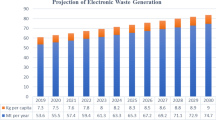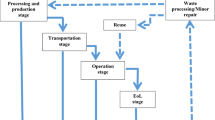Abstract
This study aims to produce sustainable thermal insulation materials from waste textiles and evaluate their environmental impact using life cycle assessment (LCA). In this study, three different insulation panels were produced using textile wastes at different percentages, temperatures, and pressure conditions. They are composed of 100% recycled cotton (N1), 90% recycled cotton/10% polylactic acid (PLA) (N2), and 42.5% recycled cotton/42.5% recycled nylon/15% PLA (N3). A cradle-to-gate LCA (starting from waste textile collection to the production of thermal insulation panels) was conducted to assess the key environmental impacts based on the ISO 14040/44 guidelines. Test results revealed that insulation materials produced from waste textiles have excellent thermal insulation properties. The obtained thermal conductive values of N1, N2, and N3 insulation materials are 0.027, 0.028, and 0.036 W/mK, respectively. In the case of environmental impacts, results showed that N1 and N2 insulation materials had lower environmental impacts than N3. Environmental impacts of produced insulation panels were also compared with some commercially available insulation materials (stone wool, recycled PET bottle, and flax). During comparison, the thickness of materials is adjusted to keep their thermal resistance value same (R = 1 m2 K/W). The LCA results showed that the insulation panels N1 and N2 have eleven and three times (respectively) lower global warming (GW) potential than stone wool and sixteen and four times (respectively) lower GW potential than flax-based insulation panels and, therefore, could be considered as comparatively higher eco-friendly products. This LCA study also exposed a clear insight into the environmental impacts of several stages of the production process, which may be helpful to optimize or modify processes and produce more eco-friendlier thermal insulation material.
Graphical abstract








Similar content being viewed by others
Abbreviations
- N1:
-
Insulation materials produced from 100% recycled cotton
- N2:
-
Insulation materials produced from 90% recycled cotton &10% PLA
- N3:
-
Insulation materials produced from 42.5% recycled cotton, 42.5% recycled nylon, and 15% PLA
- t :
-
Thickness (m)
- A :
-
Area (m2)
- w :
-
Weight (kg)
- ρ :
-
Bulk density (kg/ m3)
- R :
-
Thermal resistance (m2K/W)
- Q :
-
Heat flux (W/ m2)
- k :
-
Thermal conductivity (W/mK)
- f.u. :
-
The amount of thermal insulation materials (kg) required to meet the thermal resistance of 1 m2 K/W
- LCA:
-
Life cycle assessment
- PLA:
-
Polylactic acid
- ISO :
-
International Organization for Standardization
- PET:
-
Polyethylene terephthalate
- XPS:
-
Extruded polystyrene
- EPS:
-
Expanded polystyrene
- f.u.:
-
Functional unit
- GW:
-
Global warming
- Ad:
-
Acidification
- Cr:
-
Carcinogenic
- NC:
-
Noncarcinogenic
- RE:
-
Respiratory effects
- Eu:
-
Eutrophication
- OD:
-
Ozone depletion
- Ec:
-
Ecotoxicity
- Sm:
-
Smog formation
- PM2.5 :
-
Particles with a diameter of less than 2.5 µm
References
Islam S, Bhat G (2019) Environmentally-friendly thermal and acoustic insulation materials from recycled textiles. J Environ Manage 251:109536. https://doi.org/10.1016/j.jenvman.2019.109536
Islam S, El Messiry M, Sikdar PP et al (2022) Microstructure and performance characteristics of acoustic insulation materials from post-consumer recycled denim fabrics. J Ind Text 51:6001S-6027S. https://doi.org/10.1177/1528083720940746
Ozel M (2012) Cost analysis for optimum thicknesses and environmental impacts of different insulation materials. Energy Build 49:552–559. https://doi.org/10.1016/j.enbuild.2012.03.002
Asdrubali F, D’Alessandro F, Schiavoni S (2015) A review of unconventional sustainable building insulation materials. Sustain Mater Technol 4:1–17. https://doi.org/10.1016/j.susmat.2015.05.002
Pérez-Lombard L, Ortiz J, Pout C (2008) A review on buildings energy consumption information. Energy Build 40:394–398. https://doi.org/10.1016/j.enbuild.2007.03.007
Ürge-Vorsatz D, Cabeza LF, Serrano S et al (2015) Heating and cooling energy trends and drivers in buildings. Renew Sustain Energy Rev 41:85–98. https://doi.org/10.1016/j.rser.2014.08.039
Huberman N, Pearlmutter D (2008) A life-cycle energy analysis of building materials in the Negev desert. Energy Build 40:837–848. https://doi.org/10.1016/j.enbuild.2007.06.002
Cozzarini L, Marsich L, Ferluga A, Schmid C (2020) Life Cycle Analysis of a novel thermal insulator obtained from recycled glass waste. Dev Built Environ 3:1–7. https://doi.org/10.1016/j.dibe.2020.100014
Hadded A, Benltoufa S, Fayala F, Jemni A (2016) Thermo physical characterisation of recycled textile materials used for building insulating. J Build Eng 5:34–40. https://doi.org/10.1016/j.jobe.2015.10.007
Schiavoni S, Bianchi F, Asdrubali F (2016) Insulation materials for the building sector: A review and comparative analysis. Renew Sustain Energy Rev 62:988–1011. https://doi.org/10.1016/j.rser.2016.05.045
Schmidt AC, Jensen AA, Clausen AU et al (2004) A comparative life cycle assessment of building insulation products made of stone wool, paper wool and flax. Int J Life Cycle Assess 9:53–66. https://doi.org/10.1007/BF02978536
Intini F, Kühtz S (2011) Recycling in buildings: an LCA case study of a thermal insulation panel made of polyester fiber, recycled from post-consumer PET bottles. Int J Life Cycle Assess 16:306–315
Tingley DD, Hathway A, Davison B (2015) An environmental impact comparison of external wall insulation types. Build Environ 85:182–189. https://doi.org/10.1016/j.buildenv.2014.11.021
Patnaik A, Mvubu M, Muniyasamy S et al (2015) Thermal and sound insulation materials from waste wool and recycled polyester fibers and their biodegradation studies. Energy Build 92:161–169. https://doi.org/10.1016/j.enbuild.2015.01.056
Berardi U, Iannace G (2015) Acoustic characterization of natural fibers for sound absorption applications. Build Environ 94:840–852. https://doi.org/10.1016/j.buildenv.2015.05.029
(2017) GFA. In: Pulse Fash. Ind. https://www.globalfashionagenda.com/initiatives/pulse/#. Accessed 12 Apr 2019
Wang Y (2010) Fiber and textile waste utilization. Waste and Biomass Valoriz 1:135–143
(2023) Climate change. In: Eur. Comm. https://climate.ec.europa.eu/climate-change_en
Chen X, Memon HA, Wang Y et al (2021) Circular Economy and sustainability of the clothing and textile Industry. Mater Circ Econ 3:1–9. https://doi.org/10.1007/s42824-021-00026-2
Anjaria MK (1988) Thermal insulation properties of low density nonwoven battings. North Carolina State University, Raleigh
Rafiee MA, Rafiee J, Srivastava I et al (2010) Fracture and fatigue in graphene nanocomposites. Small 6:179–183
Dissanayake DGK, Weerasinghe DU, Wijesinghe KAP, Kalpage KMDMP (2018) Developing a compression moulded thermal insulation panel using postindustrial textile waste. Waste Manag 79:356–361. https://doi.org/10.1016/j.wasman.2018.08.001
Ricciardi P, Belloni E, Cotana F (2014) Innovative panels with recycled materials: thermal and acoustic performance and life cycle assessment. Appl Energy 134:150–162. https://doi.org/10.1016/j.apenergy.2014.07.112
Schmidt AC, Jensen AA, Clausen AU et al (2004) A comparative life cycle assessment of building insulation products made of stone wool, paper wool and flax. Int J Life Cycle Assess 9:122–129. https://doi.org/10.1007/BF02978571
Binici H, Eken M, Kara M, Dolaz M (2013) An environment-friendly thermal insulation material from sunflower stalk, textile waste and stubble fibers. In: International Conference on Renewable Energy Research and Applications. IEEE, pp 833–846
Zhou X, Zheng F, Li H, Lu C (2010) An environment-friendly thermal insulation material from cotton stalk fibers. Energy Build 42:1070–1074. https://doi.org/10.1016/j.enbuild.2010.01.020
Gounni A, Mabrouk MT, El Wazna M et al (2019) Thermal and economic evaluation of new insulation materials for building envelope based on textile waste. Appl Therm Eng 149:475–483. https://doi.org/10.1016/j.applthermaleng.2018.12.057
Mehrzad S, Taban E, Soltani P et al (2022) Sugarcane bagasse waste fibers as novel thermal insulation and sound-absorbing materials for application in sustainable buildings. Build Environ 211:108753. https://doi.org/10.1016/j.buildenv.2022.108753
La Rosa AD, Recca A, Gagliano A et al (2014) Environmental impacts and thermal insulation performance of innovative composite solutions for building applications. Constr Build Mater 55:406–414. https://doi.org/10.1016/j.conbuildmat.2014.01.054
Bribián IZ, Capilla AV, Usón AA (2011) Life cycle assessment of building materials: Comparative analysis of energy and environmental impacts and evaluation of the eco-efficiency improvement potential. Build Environ 46:1133–1140. https://doi.org/10.1016/j.buildenv.2010.12.002
Srivastava A (2023) Common insulation materials used in buildings. In: Nearby Eng. https://www.ny-engineers.com/blog/common-insulation-materials-used-in-buildings
Bhuiyan MAR, Ali A, Akter H et al (2023) Flame resistance and heat barrier performance of sustainable plain-woven jute composite panels for thermal insulation in buildings. Appl Energy 345:121317. https://doi.org/10.1016/j.apenergy.2023.121317
(2017) ASTM F1868 - 17. In: Stand. Test Method Therm. Evaporative Resist. Cloth. Mater. Using a Sweating Hot Plate. https://www.astm.org/Standards/F1868. Accessed 10 May 2022
Islam S, Bhat G (2023) A model for predicting thermal conductivity of porous composite materials. Heat Mass Transf 59:2023–2034. https://doi.org/10.1007/s00231-023-03380-w
(2006) ISO 14040. In: Environ. Manag. — Life cycle Assess. — Princ. Framew. https://www.iso.org/standard/37456.html
(2006) ISO 14044. In: Environ. Manag. -- Life cycle Assess. -- Requir. Guidel. https://www.iso.org/standard/38498.html
Llantoy Huamán NK (2019) Comparative Life Cycle Assessment of insulation materials for the building sector. https://repositori.udl.cat/bitstream/handle/10459.1/67970/nllantoyh.pdf?sequence=1
Azari R (2014) Integrated energy and environmental life cycle assessment of office building envelopes. Energy Build 82:156–162. https://doi.org/10.1016/j.enbuild.2014.06.041
Rebitzer G, Ekvall T, Frischknecht R et al (2004) Life cycle assessment: Part 1: Framework, goal and scope definition, inventory analysis, and applications. Environ Int 30:701–720. https://doi.org/10.1016/j.envint.2003.11.005
Kono J, Goto Y, Ostermeyer Y et al (2016) Factors for eco-efficiency improvement of thermal insulation materials. Key Eng Mater 678:1–13
Brunšek R, Kopitar D, Schwarz I, Marasović P (2023) Biodegradation Properties of Cellulose Fibers and PLA Biopolymer. Polymers (Basel) 15:3532. https://doi.org/10.3390/polym15173532
Sülar V, Devrim G (2019) Biodegradation behaviour of different textile fibres: visual, morphological, structural properties and soil analyses. Fibres Text East Eur. https://doi.org/10.5604/01.3001.0012.7751
An Y, Kajiwara T, Padermshoke A et al (2023) Environmental Degradation of Nylon, Poly (ethylene terephthalate)(PET), and Poly (vinylidene fluoride)(PVDF) Fishing Line Fibers. ACS Appl Polym Mater 5:4427–4436. https://doi.org/10.1021/acsapm.3c00552
Schlanbusch RD, Jelle BP, Sandberg LIC et al (2014) Integration of life cycle assessment in the design of hollow silica nanospheres for thermal insulation applications. Build Environ 80:115–124. https://doi.org/10.1016/j.buildenv.2014.05.010
Kuczenski B, Geyer R (2013) PET bottle reverse logistics—environmental performance of California’s CRV program. Int J Life Cycle Assess 18:456–471. https://doi.org/10.1007/s11367-012-0495-7
(2020) Joful Industry. In: Old Clothes Waste Text. Shredd. Mach. http://www.industrialwasteshredder.com/sale-10461514-old-clothes-waste-textile-shredder-machine-scrap-fiber-textile-waste-cutting-machine.html
(2020) Qingdao Shinejary Textile Machinery Co., Ltd. In: Text. Fabr. waste Recycl. Mach. Spinn. https://shinejary.en.alibaba.com/productgrouplist-816189902/Recying_machine.html?spm=a2700.icbuShop.88.45.200532f8BCrtko
(2020) Changshu Chenyang Nonwoven Machinery Co., Ltd. In: High Qual. Nonwoven Needle Punching Felt Mach. https://cs-chenyang.en.alibaba.com/productgrouplist-806809212/Needle_Punch_solution.html?spm=a2700.icbuShop.88.26.2804f3beFApE02
(2017) TPS. In: Ind. Therm. B. https://www.thermalproductsolutions.com/data/uploads/contentblock/Brochures/4213 TPS Industrial Thermal Book.pdf
Wendin M (2016) LCA on Recycling Cotton. https://www.researchgate.net/publication/319710965%0D. Accessed 6 June 2023
Frazer L (2004) New spin on an old fiber. Environ Health Perspect 112:754–757. https://doi.org/10.1289/ehp.112-a754
Vink ETH, Rabago KR, Glassner DA, Gruber PR (2003) Applications of life cycle assessment to NatureWorks™ polylactide (PLA) production. Polym Degrad Stab 80:403–419. https://doi.org/10.1016/S0141-3910(02)00372-5
Murphy CW, Kendall A (2013) Life cycle inventory development for corn and stover production systems under different allocation methods. Biomass Bioenerg 58:67–75. https://doi.org/10.1016/j.biombioe.2013.08.008
Landis AE (2007) The environmental impacts of biobased production. University of Illinois at Chicago. Thesis. https://hdl.handle.net/10027/13163
(2012) NREL. In: U.S. Life Cycle Invent. Database. https://www.nrel.gov/lci/
(2020) Cissco Machinery Co., Ltd. In: High Effic. Polyest. Staple Fibre Prod. Mach. https://www.alibaba.com/product-detail/High-Efficiency-Polyester-Staple-Fibre-Producing_1653737133.html?spm=a2700.7724857.normalList.25.2ebc6fc3b8ol3r&bypass=true
Bare J (2011) TRACI 2.0: the tool for the reduction and assessment of chemical and other environmental impacts 2.0. Clean Technol Environ Policy 13:687–696. https://doi.org/10.1007/s10098-010-0338-9
Islam S, Bhat G, Sikdar P (2023) Thermal and acoustic performance evaluation of 3D-Printable PLA materials. J Build Eng 67:105979. https://doi.org/10.1016/j.jobe.2023.105979
(2023) Energy Education. In: Univ. CALGARY. https://energyeducation.ca/encyclopedia/Natural_gas_power_plant
Córdoba P (2018) Emissions of inorganic trace pollutants from coal power generation. In: Olvera JDR (ed) Air Pollution—Monitoring, Quantification and Removal of Gases and Particles. IntechOpen, London, UK, pp 127–144
Author information
Authors and Affiliations
Corresponding author
Additional information
Publisher's Note
Springer Nature remains neutral with regard to jurisdictional claims in published maps and institutional affiliations.
Supplementary Information
Below is the link to the electronic supplementary material.
Rights and permissions
Springer Nature or its licensor (e.g. a society or other partner) holds exclusive rights to this article under a publishing agreement with the author(s) or other rightsholder(s); author self-archiving of the accepted manuscript version of this article is solely governed by the terms of such publishing agreement and applicable law.
About this article
Cite this article
Islam, S., Bhat, G. & Mani, S. Life cycle assessment of thermal insulation materials produced from waste textiles. J Mater Cycles Waste Manag 26, 1071–1085 (2024). https://doi.org/10.1007/s10163-023-01882-7
Received:
Accepted:
Published:
Issue Date:
DOI: https://doi.org/10.1007/s10163-023-01882-7




